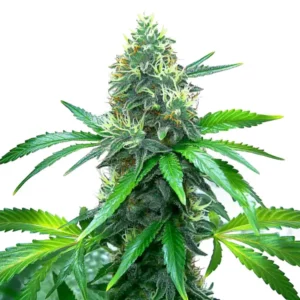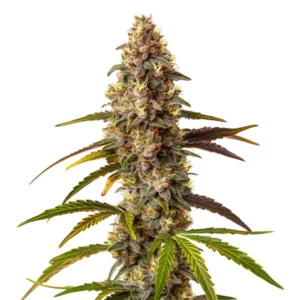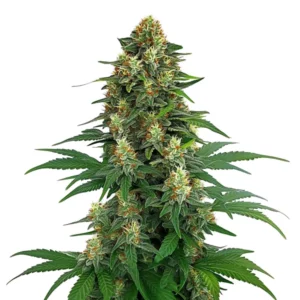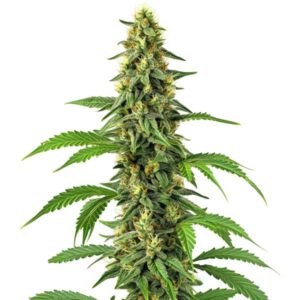
How Laticifers Affect Terpene Profiles
Laticifers are specialized cells found in many plants, including cannabis. These cells produce a milky fluid called latex. But what do laticifers have to do with terpenes? Well, understanding how laticifers affect terpene profiles is key, as they play a significant role in altering the aromatic compounds responsible for the distinctive scents and flavors of cannabis strains. If you’ve ever wondered why one strain smells like pine while another has a citrusy aroma, terpenes and the influence of laticifers are the reason.
The impacts of laticifers on terpene composition are profound. They influence how terpenes develop and change within the plant. This can make a big difference in the final product. For instance, a strain like OG Kush may have a robust earthy scent due to the laticifer activity affecting its terpene synthesis.
Recommended Strains
OG Kush
|
|
THC | 20% - 24% (Medium) |
|
|
Type | Feminized |
|
|
Yield | Medium |
|
|
Phenotype | 55% Indica / 45% Sativa |
Blue Dream
|
|
THC | 17% - 24% (Medium) |
|
|
Type | Feminized |
|
|
Yield | High |
|
|
Phenotype | 50% Indica / 50% Sativa |
How do laticifers modify terpene concentrations? It’s all about the biosynthesis process. Laticifer cells are involved in the complex chemical reactions that produce terpenes. Their activity can either enhance or diminish certain terpenes, affecting the smell and taste of the plant. This is why growers pay close attention to how laticifers influence plant terpene biosynthesis when selecting seeds.
Laticifer Influence on Cannabis Strains
Different cannabis strains have varying terpene profiles, and laticifers play a role in this variation. For example, the strain Blue Dream is known for its sweet berry aroma. This is partly due to how laticifers in this strain influence its terpene profile variation. They affect which terpenes are predominant and how strong their scent becomes.
Growers often select strains based on desired terpene outcomes. Knowing the laticifer influence on these profiles helps them make informed choices. If you’re aiming for a strain with a potent citrus aroma, you might consider how laticifers affect terpene profiles of strains like Sour Diesel. This knowledge can guide you in choosing seeds that match your preferences.
The role of laticifers in terpene profile variation cannot be overstated. They are responsible for subtle shifts in aroma that can make a strain unique. By knowing the impacts of laticifers on terpene composition, growers can better predict the aromatic outcomes of their cultivation efforts. This knowing also aids in the development of new strains that cater to specific sensory experiences.
Furthermore, laticifer activity and terpene synthesis in plants can be influenced by environmental factors, such as soil quality and climate. Recognizing how these conditions impact laticifer function allows growers to fine-tune their cultivation techniques. This results in cannabis with consistent and desirable terpene profiles, enhancing both recreational and medicinal experiences.
Terpene Biosynthesis and Laticifers
Terpene biosynthesis is the process by which plants produce terpenes. Laticifers are active participants in this process. They contribute enzymes and other compounds necessary for terpene production. This activity influences the variety and concentration of terpenes in the plant.
When growing your own cannabis, consider how laticifer activity and terpene synthesis in plants interact. A plant with highly active laticifers might produce a more intense aroma. Conversely, a strain with less laticifer activity could have subtler scents. This is why some home growers experiment with different strains to achieve their desired terpene profile.
Besides to producing enzymes, laticifers play a crucial role in shaping the chemical environment necessary for terpene biosynthesis. They facilitate the conversion of basic compounds into complex terpenes through a series of intricate reactions. Knowing how laticifers affect terpene profiles can provide insights into maximizing the aromatic potential of your cannabis plants.
Moreover, the impacts of laticifers on terpene composition extend to the overall health and resilience of the plant. By optimizing laticifer activity, growers can enhance the natural defenses of cannabis against pests and diseases. This holistic approach to cultivation not only improves terpene profiles but also supports sustainable agricultural practices.
- Laticifers produce latex, impacting terpene profiles.
- They modify terpene concentrations through biosynthesis.
- Influence varies across different cannabis strains.
- Enzymes from laticifers affect terpene production.
- Grower choices rely on knowing these impacts.
Promos & Deals
Real-Life Applications for Growers
For both beginners and seasoned growers, knowing how laticifers affect terpene profiles is crucial. It allows you to cultivate cannabis with specific qualities. If you’re targeting a certain aroma or effect, selecting the right strain with the desired laticifer activity can make all the difference.
Consider a scenario where you’re aiming for a high-limonene strain for its energetic effects. Knowing how laticifers modify terpene concentrations in strains like Tangie can guide your growing decisions. This knowledge helps in achieving the exact terpene mix you want.
Beyond aroma and flavor, the impacts of laticifers on terpene composition have practical implications for marketability. Growers who can produce strains with distinctive terpene profiles can differentiate their products in a crowded marketplace. This makes knowledge of laticifer influence a valuable asset for commercial cultivation.
Additionally, by experimenting with different growing conditions, cultivators can discover novel ways to influence laticifer activity. This experimental approach not only enhances the quality of the final product but also contributes to the collective knowing of cannabis cultivation. As research continues, new insights into laticifer roles may lead to breakthroughs in achieving unprecedented terpene profiles.

FAQs about Laticifers and Terpenes
How do laticifers contribute to terpene variation in cannabis?
Laticifers are crucial in creating terpene variation by influencing the biosynthesis process. They provide enzymes and compounds that affect how terpenes develop in different strains. This means that the same strain grown under different conditions can have varying terpene profiles depending on the laticifer activity.
For example, a grower might notice a difference in aroma between plants grown indoors versus outdoors. This is partly due to how environmental factors can alter laticifer activity, leading to changes in terpene profiles. By knowing this, growers can experiment with environmental conditions to achieve the desired terpene outcome.
Furthermore, the role of laticifers in terpene profile variation highlights the dynamic nature of cannabis cultivation. By manipulating factors such as light, temperature, and humidity, growers can actively shape the laticifer influence on plant terpene biosynthesis. This adaptability is key to producing cannabis with customized aromatic properties.
Besides recognizing how laticifers modify terpene concentrations aids in refining post-harvest processes. Methods such as curing and drying can be adjusted to preserve the desired terpene profile, ensuring the final product retains its intended aroma and flavor. This comprehensive approach underscores the importance of laticifers in the entire cultivation cycle.
Can laticifers be manipulated to enhance specific terpenes?
Yes, growers can influence laticifer activity to enhance specific terpenes. This can be done through selective breeding or by adjusting growing conditions. For instance, increasing light exposure might boost laticifer activity, enhancing certain terpenes’ presence in the plant.
Experimenting with nutrients and environmental factors can also impact laticifer function. By carefully managing these variables, growers can encourage the production of desired terpenes. This is a technique often used by experienced growers to fine-tune the aroma and taste of their cannabis.
The ability to manipulate how laticifers affect terpene profiles opens up exciting possibilities for cannabis innovation. By targeting specific laticifer activities, breeders can create new strains with unique scent and flavor combinations. This not only caters to consumer preferences but also expands the potential applications of cannabis in various industries.
Moreover, knowing the impacts of laticifers on terpene composition can lead to more sustainable cultivation practices. By optimizing laticifer functions, growers can minimize the need for external inputs such as chemical fertilizers and pesticides. This environmentally conscious approach aligns with the growing demand for eco-friendly agricultural methods.
Why are laticifers important in selecting cannabis seeds?
Laticifers are a key consideration when selecting cannabis seeds because they significantly impact the plant’s terpene profile. A strain with active laticifers can produce a more potent aroma, which might be desirable for those seeking a specific sensory experience.
When exploring seed options, consider how laticifer activity aligns with your goals. Whether you’re a first-time buyer or a seasoned cultivator, knowing this relationship can help you choose seeds that will thrive in your growing conditions and produce the desired terpene profile.
Additionally, the role of laticifers in terpene profile variation is crucial for breeders aiming to develop new and exciting strains. By selecting seeds with known laticifer characteristics, breeders can predict the aromatic outcomes and enhance the market appeal of their creations. This strategic approach to seed selection ensures that the final product meets the evolving demands of consumers.
Laticifer influence on plant terpene biosynthesis also plays a role in determining the therapeutic properties of cannabis. For medical users, selecting strains with specific laticifer attributes can enhance the efficacy of cannabis for symptom management. A thorough knowing of laticifer impacts allows for a tailored approach to both recreational and medicinal use.
How do laticifers affect the therapeutic properties of cannabis?
Laticifers influence the therapeutic properties of cannabis by affecting terpene profiles. Terpenes work synergistically with cannabinoids to enhance or modify the effects of cannabis. Therefore, a strain’s therapeutic potential can be linked to the laticifer activity and resulting terpene composition.
For medical users, selecting strains with specific terpene profiles can target certain conditions more effectively. Knowing how laticifers contribute to these profiles helps in choosing the right strain for therapeutic use, providing a tailored approach to cannabis therapy.
The impacts of laticifers on terpene composition are particularly significant in the context of medical cannabis. Terpenes such as myrcene, limonene, and linalool are known for their therapeutic benefits, and the ability to influence their concentrations through laticifer activity can enhance the overall efficacy of cannabis treatments.
Furthermore, research into how laticifers affect terpene profiles is paving the way for personalized medicine approaches. By analyzing the laticifer activity in specific strains, healthcare providers can recommend cannabis products that align with individual patient needs, optimizing therapeutic outcomes and improving quality of life.
Are there strains with minimal laticifer activity?
Some strains may exhibit minimal laticifer activity, leading to a subtler terpene profile. These strains might be preferred by users who seek a milder aroma or flavor. However, they may also lack the intense sensory experience some users desire.
When selecting such strains, consider the overall growing conditions and desired outcomes. While minimal laticifer activity might result in a less robust terpene profile, it can also provide a unique growing and consumption experience for those looking to explore different aspects of cannabis cultivation.
Strains with reduced laticifer influence can offer a unique perspective on the diversity of cannabis. While they may not deliver the pungent aromas associated with high-laticifer strains, they provide a more nuanced experience that appeals to certain consumer segments. This diversity enriches the overall cannabis landscape, offering something for everyone.
Moreover, investigating the impacts of laticifers on terpene composition in low-activity strains can yield valuable insights into the underlying mechanisms of terpene biosynthesis. By studying these strains, researchers can uncover new strategies for modulating terpene profiles, contributing to the advancement of cannabis science and cultivation techniques.




















